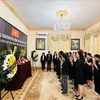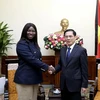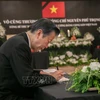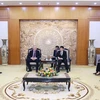The Prime Minister has approved a transport strategy in the southern key economic zone for 2020, putting public transport at the helm of urban development, especially in Ho Chi Minh City.
The plan, also including orientations to 2030, gives priority to public transport, with trains and trams in the spotlight in an effort to reduce traffic jams in big cities, especially the largest economic hub of HCM City.
It also calls for quality transport services with reasonable prices, diversification of means of transport and development of logistics.
The strategy aims to transport 1.3-1.4 billion passengers a year, thus recording an annual growth rate of between eight and nine percent, of which air passengers are estimated at 25 million. In regard to cargo, the regional system is expected to transport between 500 and 550 million tonnes a year and record an annual growth rate of 7-8 percent, of which sea ports are to play a key role for handling 265-305 million tonnes.
To meet the goal, the strategy emphasises upgrading the trans-Vietnam railway with the HCM City station as a hub and the connection of the railway system with seaports and major economic zones. It also calls for investment in new railways to complete connectivity within the region and the Mekong Delta as a whole, while conducting research on investment in the North-South Rail Express as a future project.
Deep-water ports in oil-rich Ba Ria-Vung Tau province, booming industrial Dong Nai province and HCM City are also the target of investment. Airport upgrades are needed to meet increasing demand at different stages. The construction of Long Thanh international airport is set to finish and be put into operation during this period.
The development plan focuses on several main corridors running from Ho Chi Minh City at the centre to northern Vietnam, the Mekong Delta’s Ba Ria-Vung Tau province, the Central Highlands and Cambodia.
The strategy puts domestic investment as vital, with sources coming in different forms such as State budgets, including official development assistance, bond issuance and public-private cooperation. It also calls for foreign investment./.
The plan, also including orientations to 2030, gives priority to public transport, with trains and trams in the spotlight in an effort to reduce traffic jams in big cities, especially the largest economic hub of HCM City.
It also calls for quality transport services with reasonable prices, diversification of means of transport and development of logistics.
The strategy aims to transport 1.3-1.4 billion passengers a year, thus recording an annual growth rate of between eight and nine percent, of which air passengers are estimated at 25 million. In regard to cargo, the regional system is expected to transport between 500 and 550 million tonnes a year and record an annual growth rate of 7-8 percent, of which sea ports are to play a key role for handling 265-305 million tonnes.
To meet the goal, the strategy emphasises upgrading the trans-Vietnam railway with the HCM City station as a hub and the connection of the railway system with seaports and major economic zones. It also calls for investment in new railways to complete connectivity within the region and the Mekong Delta as a whole, while conducting research on investment in the North-South Rail Express as a future project.
Deep-water ports in oil-rich Ba Ria-Vung Tau province, booming industrial Dong Nai province and HCM City are also the target of investment. Airport upgrades are needed to meet increasing demand at different stages. The construction of Long Thanh international airport is set to finish and be put into operation during this period.
The development plan focuses on several main corridors running from Ho Chi Minh City at the centre to northern Vietnam, the Mekong Delta’s Ba Ria-Vung Tau province, the Central Highlands and Cambodia.
The strategy puts domestic investment as vital, with sources coming in different forms such as State budgets, including official development assistance, bond issuance and public-private cooperation. It also calls for foreign investment./.



















